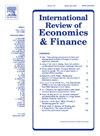Value-at-risk forecasting- based on textual information and a hybrid deep learning-based approach
IF 4.8
2区 经济学
Q1 BUSINESS, FINANCE
引用次数: 0
Abstract
The recent rise in deep learning and natural language processing (NLP) applications has notably improved productivity across different fields. This research aims to refine Value-at-Risk (VaR) model accuracy by leveraging text mining and deep learning. It first uses NLP to analyze online news sentiments, integrating these as variables to boost stock market risk forecasts and assess their effect on VaR accuracy. Additionally, the study combines predictions from four unique Generalized AutoRegressive Conditional Heteroskedasticity (GARCH)-type models into advanced Long Short-Term Memory (LSTM) and Convolutional Neural Network (CNN)-LSTM models to see if this boosts VaR precision. It also explores how textual data impacts VaR predictions over short and longer periods, using 7 and 20-day rolling windows. The analysis, using S&P500 (SPY), Dow Jones Industrial Average (DJI), and Nasdaq Composite (IXIC) data from 2012 to 2023 alongside news headlines, tests these approaches. The results confirm that incorporating textual information into the VaR model enhances its forecasting accuracy, highlighting the benefits of applying deep learning techniques in this process.
基于文本信息和基于深度学习的混合方法的风险价值预测
最近深度学习和自然语言处理(NLP)应用的兴起显著提高了不同领域的生产力。本研究旨在通过利用文本挖掘和深度学习来改进风险价值(VaR)模型的准确性。它首先使用NLP分析在线新闻情绪,将这些作为变量整合起来,以提高股市风险预测,并评估它们对VaR准确性的影响。此外,该研究将四种独特的广义自回归条件异方差(GARCH)型模型的预测结合到高级长短期记忆(LSTM)和卷积神经网络(CNN)-LSTM模型中,以观察这是否能提高VaR精度。它还探讨了文本数据如何影响短期和长期的VaR预测,使用7天和20天的滚动窗口。本文利用2012年至2023年标准普尔500指数(s&p P500)、道琼斯工业平均指数(Dow Jones Industrial Average)和纳斯达克综合指数(Nasdaq Composite)的数据,以及新闻标题,对上述方法进行了检验。结果证实,将文本信息纳入VaR模型可以提高其预测准确性,突出了在此过程中应用深度学习技术的好处。
本文章由计算机程序翻译,如有差异,请以英文原文为准。
求助全文
约1分钟内获得全文
求助全文
来源期刊
CiteScore
7.30
自引率
2.20%
发文量
253
期刊介绍:
The International Review of Economics & Finance (IREF) is a scholarly journal devoted to the publication of high quality theoretical and empirical articles in all areas of international economics, macroeconomics and financial economics. Contributions that facilitate the communications between the real and the financial sectors of the economy are of particular interest.

 求助内容:
求助内容: 应助结果提醒方式:
应助结果提醒方式:


